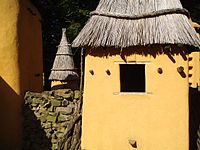Egyptian Revival architecture
A: TheEgyptian Hallin London (1812-destroyed in 1905); B: 1862 lithograph of the Aegyptischer Hof (English: Egyptian court), from theNeues Museum,Berlin (early of mid-19th century); C: Interior of the Temple maçonnique des Amis philanthropes inBrussels,Belgium(1877-1879); D:Egyptian Theatre,Colorado,U.S.(1928) | |
| Years active | Late 18th-present |
|---|---|
Egyptian Revivalis anarchitectural stylethat uses the motifs and imagery ofancient Egypt.It is attributed generally to the public awareness of ancient Egyptian monuments generated byNapoleon'sconquest of EgyptandAdmiral Nelson's defeat of theFrench Navyat theBattle of the Nilein 1798. Napoleon took a scientific expedition with him to Egypt. Publication of the expedition's work, theDescription de l'Égypte,began in 1809 and was published as a series through 1826. The size and monumentality of the façades discovered during his adventure cemented the hold of Egyptian aesthetics on the Parisian elite. However, works of art and architecture (such as funerary monuments) in the Egyptian style had been made or built occasionally on the European continent since the time of theRenaissance.
History[edit]
Egyptian influence before Napoleon[edit]
Much of the early knowledge about ancient Egyptian arts and architecture was filtered through the lens of the Classical world, including ancient Rome. Prior toNapoleon's influence an early example is theObeliskofDomitian,erected in 1651 byBerninion top of theFontana dei Quattro FiumiinPiazza Navona,Rome,which went on to inspire several Egyptian obelisks constructed in Ireland during the early 18th century. It influenced the obelisk constructed as a family funeral memorial by SirEdward Lovett Pearcefor theAllen familyatStillorganin Ireland in 1717, one of several Egyptian obelisks erected in Ireland during the early 18th century. Others may be found at Belan,County Kildare;and Dangan, County Meath.Conolly's Follyin County Kildare is probably the best known, albeit the least Egyptian-styled.
Egyptian buildings had also been built asgarden follies.The most elaborate was probably the one built by DukeFrederick I of Württembergin the gardens of theChâteau de Montbéliard.It included an Egyptian bridge across which guests walked to reach an island with an elaborate Egyptian-influencedbath house.Designed byJean-Baptiste Kléber,later French commander in Egypt, the building had a billiards room and abagnio.
During the 2nd half of the 18th century, with the rise ofNeoclassicism,sometimes architects mixed theAncient Greek,RomanandEgyptianstyles. They wanted to discover new shape and ornament ideas, rather than to be just faithful copyists of the past.[1]
-
Pyramid of Cestius,Rome, by Gaius Cestius,c.12 BC
-
Renaissancemonument toLavinia Thiene,with an Egyptian-inspired pyramid on it,Vicenza Cathedral,Vicenza,Italy, byGiulio Romano,1544
-
Mural decoration for the Caffè degli Inglesi, Piazza di Spagna, Rome,Metropolitan Museum of Art,New York City, byGiovanni Battista Piranesi,1769[3]
-
Pyramid in the gardens ofParc Monceau,Paris, unknown architect, 1778
-
Cenotaph in Egyptian Style,Bibliothèque Nationale de France,Paris, byÉtienne-Louis Boullée,c.1786
-
Cenotaph of ArchduchessMaria Christina, Duchess of Teschen,Augustinian Church, Vienna,Austria,byAntonio Canova,1798-1805[6]
-
Design for the Elysium, byLouis-Sylvestre Gasse,1799[8]
Napoleonic and Post-Napoleonic eras[edit]
New after the Napoleonic invasion was a sudden increase of the number of works of art and the fact that, for the first time, entire buildings began to be built to resemble those of ancient Egypt. In France and Britain this was at least partially inspired by successful war campaigns undertaken by each country while in Egypt.
For Napoleon's intention of cataloguing the sights and findings from the campaign, hundreds of artists and scientists were enlisted to document “antiquities, ethnography, architecture, and natural history of Egypt”; and later these notes and sketches were taken back to Europe. In 1803, the compilation of “Description de l'Égypte”was started based on these documents and lasted over twenty years. The content in this archaeological text, includes translation of theRosetta Stone,pyramids and other scenes, arouse interests in Egyptian arts and culture in Europe and America.
According toJames Stevens Curl,people started to present their imaginations about Egypt in various ways. First, combinations of crocodiles, pyramids, mummies, sphinxes, and other motifs were widely circulated. In 1800, an Egyptian opera festival was staged inDrury Lane,London, with Egyptian-themed sets and costumes. On the other hand,William Capon(1757–1827) suggested a massive pyramid forShooter's Hillas a National Monument, whileGeorge Smith(1783–1869) designed an Egyptian-style tomb forRalph AbercrombyinAlexandria.
According toDavid Brownlee,the 1798Karlsruhe Synagogue,an early building by the influentialFriedrich Weinbrennerwas "the first large Egyptian building to be erected since antiquity."[9]According toDiana Muir,it was "the first public building (that is, not a folly, stage set, or funeral monument) in the Egyptian revival style."[10]The ancient Egyptian influence was mainly shown in the two large engagedpylonsflanking the entrance; otherwise the windows and entrance of the central section were pointed arches, and the overall plan conventional, withNeo-Gothicdetails.
Among the earliest monuments of the Egyptian Revival in Paris is theFontaine du Fellah,built in 1806. It was designed byFrançois-Jean Bralle.A well-documented example, destroyed after Napoleon was deposed, was the monument to GeneralLouis Desaixin thePlace des Victoireswas built in 1810. It featured a nude statue of the general and an obelisk, both set upon an Egyptian Revival base.[11]Another example of a still standing site of Egyptian Revival is theEgyptian Gate of Tsarskoe Selo,built in 1829.
A street or passage named the Place du Caire or Foire du Caire (Fair of Cairo) was built in Paris in 1798 on the former site of the convent of the "Filles de la Charité". No. 2 Place du Caire, from 1828, is essentially in overall form a conventional Parisian structure with shops on the ground floor and apartments above, but with considerable Egyptianizing decoration including a row of massiveHathorheads and a frieze by sculptor J. G. Garraud.[12]
One of the first British buildings to show an Egyptian Revival interior was the newspaper office of theCourieron theStrand, London.It was built in 1804 and featured acavetto(coved)corniceand Egyptian-influenced columns with palmiformcapitals.[13]Other early British examples include theEgyptian Hallin London, completed in 1812, and the Egyptian Dining Room atGoodwood House(1806). There was also the Egyptian Gallery, a private room in the home of connoisseurThomas Hopeto display his Egyptian antiquities, and illustrated in engravings from his meticulous line drawings in his bookHousehold Furniture(1807), were a prime source for theRegency styleof British furnishings.
-
Portico of theHôtel Beauharnais,Paris, by L.E.N. Bataille,c.1804[14]
-
Fontaine du Fellah,Paris, byFrançois-Jean Bralle,1806
-
Egyptian room design, unknown location, byThomas Hope,1807
-
Sphinx of theFontaine du Palmier,Paris, unknown sculptor, 1808 and 1858
-
Design for an Egyptian set for Act II ofThe Magic Flute,byKarl Friedrich Schinkel,1815, watercolour on paper,Bibliothèque de l'Opéra National,Paris[15]
-
Peter Frederick Robinson'sEgyptian Hall(England's Home of Mystery),Wellcome Collection,London, by A. McClatchy afterThomas H. Shepherd,1828[3]
Rise of Egyptian Revival in America[edit]

The first Egyptian Revival building in the United States was the 1824 synagogue ofCongregation Mikveh IsraelinPhiladelphia.[16]It was followed by a series of major public buildings in the first half of the 19th century including the 1835Moyamensing Prison,Philadelphia, Pennsylvania, United States, the 1836 Fourth District Police Station in New Orleans and the 1838 New York City jail known asthe Tombs.Other public buildings in Egyptian style included the 1844Old Whaler's ChurchinSag Harbor, New York,the 1846First Baptist Church of Essex, Connecticut,the 1845Egyptian Buildingof theMedical College of Virginiain Richmond and the 1848United States Custom House (New Orleans).The most notable Egyptian structure in the United States was theWashington Monument,begun in 1848, this obelisk originally featured doors with cavetto cornices and winged sun disks, later removed. TheNational World War I Museum and MemorialinKansas City, Missouri,is another example of Egyptian revival architecture and art.[17]
Around the 1870s, Americans started to become interested in other cultures, including those of Japan, the Middle East and North Africa, leading to a second period of interest in Egyptian revival. Egyptian motifs and symbols were commonly used in the design including elements of "gilt bronze fittings shaped like sphinxes, Egyptian scenes woven into textiles, and geometric renderings of plants such as palm fronds".[18]
Some Americans in the 1880s believed that the United States was a nation without art and therefore wanted to innovate in the field of aesthetic design to distinguish it from Egyptian pyramids and obelisks, Greek temples, and Gothic spires. But implementing such innovations was difficult, and asClarence Kingsaid, “Till there is an American race there cannot be an American style”. The creation of the American style was also hindered by the fact that the ethnic mix of the American people did not constitute a race.[19]In the time that followed, however, America's own culture was assimilating Egyptian revivalist architecture, and their tectonic significance became unstable. This may be because the United States of the early 20th century was a confident nation, and the approach of defining one's own spiritual world by establishing a connection to a great civilization like ancient Egypt faded in such a cultural context.[20]
Other countries[edit]
TheSouth African Collegein the then-BritishCape Colonyfeatures an "Egyptian building" constructed in 1841; the Egyptian Revival building of theCape Town Hebrew Congregationis also still standing.
The York Street Synagogue was Australia's first Egyptian revival building, followed by theHobart Synagogue,theLaunceston Synagogueand the Adelaide Hebrew Congregation, all by 1850. The earliest obelisk in Australia was erected atMacquarie Place,Sydney in 1818.[21]
Later revivals[edit]
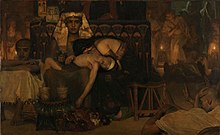
The expeditions that eventually led to thediscovery in 1922 of Tutankhamun's tombby archaeologistHoward Carterresulted in a 20th-century revival. The revival during the 1920s is sometimes considered to be part of theArt Decostyle. This phase gave birth to theEgyptian Theatremovement, largely confined to the United States. TheEgyptian Revival decorative artsstyle was present in furniture and other household objects, as well as in architecture.
-
Entrance to Egyptian Avenue of theHighgate Cemetery,London, unknown architect, 19th century[22]
-
Mixed withNeoclassicism- Grave ofLouis PoinsotinPère-Lachaise Cemeteryin Paris, byDavid d'Angers,mid-19th century
-
Entry gate of theMount Auburn Cemetery,located on the line betweenCambridgeandWatertown,Massachusetts, byJacob Bigelow[23]
-
Façade of theMasonic Temple of Santa Cruz de Tenerife,by Manuel de Cámara, 1899-1902.
-
Mixed withArt Nouveau-Stained glasswindow of the Romulus Porescu House, decorated with lotus flowers,Bucharest,Romania,1905, byDimitrie Maimarolu[25]
-
Mixed with Art Nouveau - Egyptian House (Rue du Général Rapp no. 10),Strasbourg,France, designed by the architectFranz Scheyderin collaboration with painterAdolf Zilly,1905-1906[26]
-
Mixed withRomanian Revivaland Art Deco - Cenușa Crematory, mi xing Egyptian Revival volumes and shapes with other styles, Bucharest, byDuiliu Marcu,1925-1934
-
Mixed with Art Deco - Grave of Lang-Verte, Père-Lachaise Cemetery, unknown architect,c.1920s
-
Mixed with Art Deco - Elevator door in theChrysler Building,New York City, byWilliam van Alen,1929-1930
-
Mixed withPostmodernism-Luxor Hotel and CasinoinLas Vegas,byVeldon SimpsonandPerini Building Company,1992–1993[30]
Hieroglyphics[edit]
Many notable works in Britain featured attempts by architects to translate and depict messages inEgyptian hieroglyphs.[31]Although sincere attempts at compositions, understanding of hieroglyphic syntax and semantics has advanced since they were built and errors have been discovered in many of these works. Although both public and private buildings were built in Britain in the Egyptian Revival style, the vast majority of those with attempts at accurate inscriptions were public works or on entrances to public buildings.[31]
In 1824, French classical scholar and egyptologistJean-François ChampollionpublishedPrecis du systeme hieroglyphique des anciens Egyptiensin 1824, which spurred the first notable attempts to decipher the hieroglyphic language in Britain.[31]Joseph Bonomi the Younger's inscriptions in the entrance lodges toAbney Park Cemeteryin 1840 was the first real recorded attempt to compose a legible text. An Egyptologist himself, Bonomi and other scholars such asSamuel Birch,Samuel Sharpe,William Osburne, and others[31]would compose texts for a variety of other British projects throughout the nineteenth century includingMarshall's Millin Leeds, anaediculain the grounds ofHartwell House, Buckinghamshire,and as part of an Egyptian exhibition inThe Crystal Palaceafter it was re-erected in southeast London.[31]
The content of the inscriptions varied depending on the nature of their specific projects. The Crystal Palace exhibition features several different inscriptions, with the main inscription detailing the construction and content of the hall and proclaiming it as an educational asset to the community. It ends with a message to invoke good fortune, translated as 'let it be prosperous.[31]' Other smaller inscriptions on the cornice of the exhibit entrance feature the names of the builders and a message in Greek wishing for the health and well-being ofQueen VictoriaandPrince Albert,[31]members of the royal family. The main inscription is accompanied by an English translation, with the characters spaced to match the position of the English words. However, Chris Elliot notes that the translation overly relies on phonetic transliteration and features some unusual characters for words that were difficult to translate into hieroglyphs.[31]
List of buildings[edit]
North America[edit]
- First Presbyterian Church in Nashville, Tennessee; designed byWilliam Stricklandfrom 1849 to 1851
- Washington Monumentin Washington, D.C.
- Battle Monumentin Baltimore, Maryland
- New Jersey State Penitentiaryin Trenton, New Jersey; designed byJohn Havilandfrom 1833 to 1836
- Medical Collegeat Richmond in Richmond, Virginia, designed byThomas Somerville Stewartin 1845
- 1826–1830:Groton MonumentinGroton, Connecticut
- 1834-1835:American Institutein New York City
- 1835:Moyamensing Prisonin Philadelphia; designed byThomas Ustick Walter;demolished in 1968
- 1836: 4th Precinct Police Station on Rousseau Street in New Orleans. Designed by Benjamin Buisson, it originally served as a jail and police station. Later altered significantly; now used by theKnights of Babylonkrewefor Mardi Gras float storage
- 1838:Green-Wood Cemeteryin New York City
- 1838:The Tombs,a court and jail complex in New York City by John Haviland; demolished in 1902
- 1838: Pennsylvania Fire Insurance building in Philadelphia [1] by John Haviland
- 1840: Gates of theGranary Burying Ground,byIsaiah Rogers,inBoston
- 1842:Croton Distributing Reservoirin New York City
- 1827–1843:Bunker Hill Monumentin theCharlestonneighborhood of Boston
- 1843: Gates and gatehouses ofMount Auburn CemeteryinCambridge, Massachusetts;designed byJacob Bigelow
- 1844:Old Whaler's Church,Sag Harbor, New York;designed byMinard Lafever
- 1845: Thebrownstoneentry gates of theGrove Street Cemetery,byHenry Austin,New Haven, Connecticut,United States
- 1846:First Baptist Church of Essex, Connecticut
- 1856:Skull and Bonesundergraduate secret society atYale Universityin New Haven, Connecticut (architect's attribution in dispute—may also be Henry Austin of the Grove Street Cemetery gates)
- 1894:The Cairoapartment building in Washington, D.C.
- 1914: Masonic Temple in Charlotte, North Carolina (1914–87)
- 1914-1916:Winona Savings Bank BuildinginWinona, Minnesota
- 1920: Marmon Hupmobile Showroom inChicago;designed by Paul Gerhardt
- 1922:Grauman's Egyptian Theatrein Los Angeles
- 1927:Pythian Temple (New York City)
- 1928:Lincoln Theatre (Columbus, Ohio);has an Egyptian revival interior
- 1939:Social Security Administration Building (Washington, DC)
- 1966:Rosicrucian Egyptian MuseuminSan Jose, California
Europe, Russia, Africa and Australia[edit]
- 18–12 BCPyramid of Cestius,Rome
- 1798Karlsruhe Synagogue
- circa 1820:Donkin MemorialinPort Elizabeth,South Africa
- 1822: Egyptian temple inŁazienki ParkinWarsaw,Poland
- 1824: 42 Fore Street inHertford,known locally as the Egyptian House, is anEnglish HeritageGrade IIlisted buildingbuilt on the site of a former inn. Agrocery storefrom the Victorian era until the 1960s, now a restaurant.
- 1825–1826:Egyptian Bridgein St. Petersburg; collapsed on 20 January 1905, but 1955 replacement incorporated sphinxes and several portions of it remains
- 1827–1830:Egyptian Gate of Tsarskoe Selo,St. Petersburg
- 1835–1837:Egyptian House, Penzance,Cornwall. Built by local bookseller John Lavin as a museum, it is still standing.
- 1836-1840:Temple Works,a former flax mill in the industrial district ofHolbeckinLeeds,England; built for textile industrialistJohn Marshalland held the distinction of being the largest single room in the world when it was built
- 1838–1839: The Egyptian Avenue and inner circle of the Lebanon Circle inHighgate Cemeteryin London
- 1838–1840:Temple Lodges Abney ParkinLondon Borough of Hackney
- 1844:Launceston SynagogueinLaunceston, Tasmania
- 1845:Hobart SynagogueinHobart,Tasmania
- 1839-1849Thorvaldsen Museum,Copenhagen, Denmark.
- 1846–1848:Old Synagogue at Canterbury,England
- 1849:Cape Agulhas Lighthouse,the second-oldest lighthouse in South Africa; also called the "Pharos of the South"
- 1856: Egyptian Temple housing elephants at theAntwerp Zoo;designed by Charles Servais
- 1862–1864: Egyptian temple in the park ofStibbert MuseuminFlorence,Italy
- 1870:The Egyptian Hallsin Glasgow; designed byAlexander Thomson
- 1881–1889:Mausoleo SchilizziinNaples,Italy
- 1891: The Typhonium nearWissantby the Belgian architect Edmond De Vigne
- 1899:Sha'ar Hashamayim Synagogue (Cairo)
- 1902:Masonic Temple of Santa Cruz de Tenerife,Spain
- 1914: Regional Studies Museum inKrasnoyarsk,Russia
- 1919:Mukhtar Museumin Cairo
- 1921: Louxor theater inParis
- 1922: Collège des Frères d'Heliopolis in Cairo
- 1925: AbdulHamid al-Shawarby Pasha building in Cairo
- 1927: Emulation Hall,Melbourne, Australia
- 1927:Mausoleum of Saad Zaghloulin Cairo
- 1927– 1928: Collins & Parri's Arcadia Works for Carreras, London
- 1924–1929:Lenin's Mausoleumin Moscow; designed byAleksey Shchusevusing elements borrowed from thePyramid of Djoser
- 1926–1928:Carreras Cigarette FactoryinCamden,London
- 1930: foyer ofOliver Percy Bernard's Strand Palace Hotel, London (destr. 1967–8; parts now London, V&A)
- 1932: Ismailia Monuments Museum inIsmailia,Egypt
- 1933:Moussa Dar'i Synagoguein Cairo
- 1934 Pyramid Theatre,Sale, Greater Manchester,UK (formerly a cinema, both independent andOdeonnow aSports Direct)
- 1930–1937:National Museum of Beirut
- 1934: Former Perth Girls' School inPerth, Western Australia,Australia
- 1937:Manly Town HallinManly, New South Wales,Australia
- 1942:Faculty of Engineering, Alexandria Universitycampus inAlexandria,Egypt
- 1946: Royal Rest House,Giza Pyramid Complex,Giza,Egypt
- 1961:Cairo Towerin Cairo
- 1974:Unknown Soldier Memorial (Egypt)in Cairo
- Unknown: Lamati Court inMinya,Egypt
Post-Modern variants[edit]
- 1989:Louvre Pyramidin Paris
- 1991:Pyramid ArenainMemphis, Tennessee
- 1992:Cheesecake Factory[clarification needed]
- 1993:Tama-ReinEatonton, Georgia;demolished 2005
- 1993:Luxor Hotel and CasinoinLas Vegas
- 1995: City Stars Heliopolis in Cairo
- 1996: The Lost World of Reptiles, an exhibit at theAustralian Reptile Park,Somersby, New South Wales,Australia
- 1997:Wafi City,Wafi, Dubai City, Dubai UAE
- 1997:Sunway Pyramid,Bandar Sunway,Malaysia.
- 2001: Embassy of the Arab Republic of Egypt inBerlin
- 2001:Supreme Constitutional Court of Egyptbuilding, Cairo
- 2001:Scotiabank TheatreChinook CentreinCalgary,Alberta
- 2010:Sohag International Airportterminal building inSohag,Egypt
- 2010:Fairmont Nile City,Cairo
- 2019–present:New Administrative Capital,Egypt, includingIconic Tower (Egypt),Oblisco Capitale,The Octagon (Egypt),Egyptian New Parliament, Presidential Palace and more
- 2022: Cairo Security Directorate, New Cairo, Egypt
See also[edit]
- Egyptian Revival decorative arts
- Ancient Egyptian architecture
- Egyptian Revival architecture in the British Isles
- List of pyramid mausoleums in North America
- Egyptomania in the United States
Notes[edit]
- ^Bergdoll 2000,pp. 23.
- ^Sund 2019,p. 221.
- ^abSund 2019,p. 210.
- ^Borngässer, Barbara (2020).POTSDAM - Art, Architecture abd Landscape.Vista Point. p. 292.ISBN978-3-96141-579-3.
- ^Bergdoll 2000,pp. 113.
- ^Argan, Giulio Carlo (1982).Art Modernă(in Romanian). Editura Meridiane.
- ^Paris(in French). 1997. p. 296.ISBN2-85088-150-3.
- ^Gössel, Peter; Leuthäuser, Gabriele (2022).Architecture in the 20th Century.TASCHEN. p. 11.ISBN978-3-8365-7090-9.
- ^David Brownlee,Frederich Weinbrenner: Architect of Karlsruhe,University of Pennsylvania Press, 1986. p. 92.
- ^Diana Muir Appelbaum,"Jewish Identity and Egyptian Revival Architecture",Journal of Jewish Identities,2012, 5(2) p. 7.
- ^Curl, James Stevens (2005).The Egyptian Revival.Psychology Press. p. 276.ISBN9780415361194.
- ^James Stevens Curl,The Egyptian Revival,Routledge/* Post-Napoleonic era */, London, 2005. p. 267.
- ^Egyptomania: Egypt in Western Art, 1730–1930,Jean-Marcel Humbert, Michael Pantazzi and Christiane Ziegler, 1994, pp. 172–3
- ^Sund 2019,p. 216.
- ^Graham-Nixon, Andrew (2023).art THE DEFINITIVE VISUAL HISTORY.DK. p. 309.ISBN978-0-2416-2903-1.
- ^Diana Muir,"Jewish Identity and Egyptian Revival Architecture", Journal of Jewish Identities, 2012 5(2)
- ^"Elements of the Museum and Memorial | National WWI Museum and Memorial".National WWI Museum and Memorial.2013-03-01.Retrieved2018-11-02.
- ^Ickow, Sara (July 2012)."Egyptian Revival".metmuseum.org.Archivedfrom the original on 2012-11-05.Retrieved2021-09-30.
- ^Giguere, Joy M. (2014).Characteristically American: memorial architecture, national identity, and the Egyptian revival(1st ed.). Knoxville: The University of Tennessee Press.ISBN978-1-62190-077-1.OCLC893336717.
- ^Grubiak, Margaret M. (2016)."Characteristically American: Memorial Architecture, National Identity, and the Egyptian Revival by Joy M. Giguere".Technology and Culture.57(1): 256–257.doi:10.1353/tech.2016.0009.ISSN1097-3729.S2CID112725318.
- ^Humbert, Jean-Marcel and Price, Clifford, eds.,Imhotep Today: Egyptianizing Architecture,UCL Prewss, 2003, pp. 167 ff.
- ^Sund 2019,p. 222.
- ^Sund 2019,p. 223.
- ^Hopkins 2014,p. 130.
- ^Constantin, Paul (1972).Arta 1900 în România(in Romanian). Editura Meridiane. p. 93.
- ^Thibaut."The Egyptian House Of Strasbourg".enjoystrasbourg.Retrieved19 August2023.
- ^Texier, Simon (2022).Architectures Art Déco - Paris et Environs - 100 Bâtiments Remarquable.Parigramme. p. 37.ISBN978-2-37395-136-3.
- ^Sund 2019,p. 224.
- ^van Lemmen, Hans (2013).5000 Years of Tiles.The British Museum Press. p. 246.ISBN978-0-7141-5099-4.
- ^Sund 2019,p. 212.
- ^abcdefghElliot, Chris (2013). "Compositions in Egyptian Hierogylphs in Nineteenth Century England".The Journal of Egyptian Archaeology.99:171–189.doi:10.1177/030751331309900108.S2CID193273948– via JSTOR.
References[edit]
- Bergdoll, Barry (2000).European Architecture 1750-1890.Oxford University Press.ISBN978-0-19-284222-0.
- Hopkins, Owen (2014).Architectural Styles: A Visual Guide.Laurence King.ISBN978-178067-163-5.
- Sund, July (2019).Exotic: A Fetish for the Foreign.Phaidon.ISBN978-0-7148-7637-5.
External links[edit]
 Media related toEgyptian Revival architectureat Wikimedia Commons
Media related toEgyptian Revival architectureat Wikimedia Commons


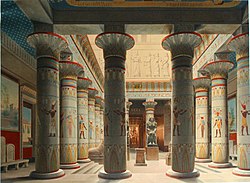
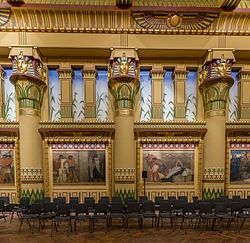
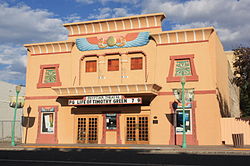

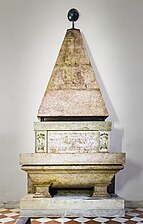
![Pyramid grave, churchyard in Järfälla, Sweden, unknown architect, 18th century[2]](https://upload.wikimedia.org/wikipedia/commons/thumb/c/cc/Adlerbergska_gravkoret%2C_J%C3%A4rf%C3%A4lla_kyrka%2C_2014b.jpg/300px-Adlerbergska_gravkoret%2C_J%C3%A4rf%C3%A4lla_kyrka%2C_2014b.jpg)
![Mural decoration for the Caffè degli Inglesi, Piazza di Spagna, Rome, Metropolitan Museum of Art, New York City, by Giovanni Battista Piranesi, 1769[3]](https://upload.wikimedia.org/wikipedia/commons/thumb/a/aa/Piranesi_-_Caff%C3%A8_degli_Inglesi_02.jpg/305px-Piranesi_-_Caff%C3%A8_degli_Inglesi_02.jpg)
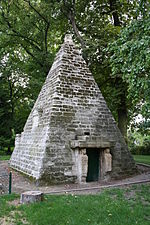

![Pyramid used as a cold store, New Garden, Potsdam, Germany, by Andreas Ludwig Krüger, 1791-1792[4]](https://upload.wikimedia.org/wikipedia/commons/thumb/8/83/Pyramide3.jpg/300px-Pyramide3.jpg)
![Project to transform the Panthéon, by Charles de Wailly, 1797[5]](https://upload.wikimedia.org/wikipedia/commons/thumb/7/70/Project_to_transform_the_Panth%C3%A9on%2C_by_Charles_de_Wailly%2C_1797.jpg/183px-Project_to_transform_the_Panth%C3%A9on%2C_by_Charles_de_Wailly%2C_1797.jpg)
![Cenotaph of Archduchess Maria Christina, Duchess of Teschen, Augustinian Church, Vienna, Austria, by Antonio Canova, 1798-1805[6]](https://upload.wikimedia.org/wikipedia/commons/thumb/e/e9/Wien_Augustinerkirche_Kenotaph_Maria_Christina_1.jpg/262px-Wien_Augustinerkirche_Kenotaph_Maria_Christina_1.jpg)
![Passage du Caire (Place du Caire no. 2), Paris, by Philippe-Laurent Prétrel, 1798[7]](https://upload.wikimedia.org/wikipedia/commons/thumb/9/99/2_Place_du_Caire%2C_Paris_%2807%29.jpg/132px-2_Place_du_Caire%2C_Paris_%2807%29.jpg)
![Design for the Elysium, by Louis-Sylvestre Gasse, 1799[8]](https://upload.wikimedia.org/wikipedia/commons/thumb/1/12/Elysium%2C_by_Louis-Sylvestre_Gasse%2C_1799%2C_Biblioth%C3%A8que_de_l%27%C3%89cole_nationale_sup%C3%A9rieure_des_Arts_d%C3%A9coratifs%2C_Paris.jpg/321px-Elysium%2C_by_Louis-Sylvestre_Gasse%2C_1799%2C_Biblioth%C3%A8que_de_l%27%C3%89cole_nationale_sup%C3%A9rieure_des_Arts_d%C3%A9coratifs%2C_Paris.jpg)
![Portico of the Hôtel Beauharnais, Paris, by L.E.N. Bataille, c.1804[14]](https://upload.wikimedia.org/wikipedia/commons/thumb/6/60/H%C3%B4tel_de_Beauharnais.jpg/202px-H%C3%B4tel_de_Beauharnais.jpg)
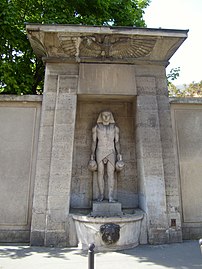
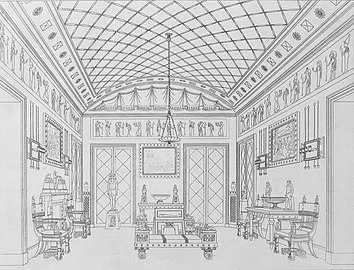

![Design for an Egyptian set for Act II of The Magic Flute, by Karl Friedrich Schinkel, 1815, watercolour on paper, Bibliothèque de l'Opéra National, Paris[15]](https://upload.wikimedia.org/wikipedia/commons/thumb/7/78/Schinkel_Szenenentwurf_Zauberfl%C3%B6te_Feuer-_und_Wasserprobe.jpg/396px-Schinkel_Szenenentwurf_Zauberfl%C3%B6te_Feuer-_und_Wasserprobe.jpg)
![Peter Frederick Robinson's Egyptian Hall (England's Home of Mystery), Wellcome Collection, London, by A. McClatchy after Thomas H. Shepherd, 1828[3]](https://upload.wikimedia.org/wikipedia/commons/thumb/2/2a/Egyptian_Hall%2C_Piccadilly_-_Shepherd%2C_Metropolitan_Improvements_%281828%29%2C_p295_%28edited%29.jpg/428px-Egyptian_Hall%2C_Piccadilly_-_Shepherd%2C_Metropolitan_Improvements_%281828%29%2C_p295_%28edited%29.jpg)

![Entrance to Egyptian Avenue of the Highgate Cemetery, London, unknown architect, 19th century[22]](https://upload.wikimedia.org/wikipedia/commons/thumb/7/77/Egyptian_Avenue_Highgate_Cemetery.jpg/360px-Egyptian_Avenue_Highgate_Cemetery.jpg)
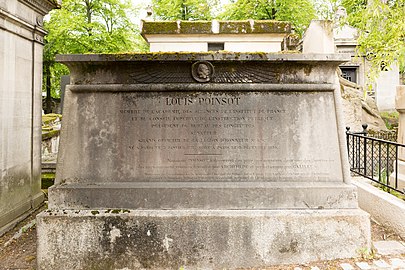
![Entry gate of the Mount Auburn Cemetery, located on the line between Cambridge and Watertown, Massachusetts, by Jacob Bigelow[23]](https://upload.wikimedia.org/wikipedia/commons/thumb/8/81/Main_gate_of_Mount_Auburn_Cemetery_-_080154pu.tif/lossy-page1-378px-Main_gate_of_Mount_Auburn_Cemetery_-_080154pu.tif.jpg)
![Egyptian Building, part of the Virginia Commonwealth University, Richmond, Virginia, by Thomas Somerville Stewart, 1845[24]](https://upload.wikimedia.org/wikipedia/commons/thumb/d/dc/Egyptian_Building.JPG/360px-Egyptian_Building.JPG)

![Mixed with Art Nouveau - Stained glass window of the Romulus Porescu House, decorated with lotus flowers, Bucharest, Romania, 1905, by Dimitrie Maimarolu[25]](https://upload.wikimedia.org/wikipedia/commons/thumb/8/8e/Negustori_col%C8%9B_cu_Paleologu._-streetphotography_-bucharest_-windows_-rusty_-old_%2834264373636%29.jpg/270px-Negustori_col%C8%9B_cu_Paleologu._-streetphotography_-bucharest_-windows_-rusty_-old_%2834264373636%29.jpg)
![Mixed with Art Nouveau - Egyptian House (Rue du Général Rapp no. 10), Strasbourg, France, designed by the architect Franz Scheyder in collaboration with painter Adolf Zilly, 1905-1906[26]](https://upload.wikimedia.org/wikipedia/commons/thumb/b/b5/Strasbourg_%28Bas-Rhin%29_-_Neustadt_-_%22Maison_%C3%A9gyptienne%22_%28Scheyder_et_Zilly%2C_1905-1906_%29_%2810_rue_du_G%C3%A9n%C3%A9ral_Rapp%29_-_52307809924.jpg/414px-Strasbourg_%28Bas-Rhin%29_-_Neustadt_-_%22Maison_%C3%A9gyptienne%22_%28Scheyder_et_Zilly%2C_1905-1906_%29_%2810_rue_du_G%C3%A9n%C3%A9ral_Rapp%29_-_52307809924.jpg)
![Mixed with Art Deco - Le Louxor Cinema, Paris, by Henri Zipcy, 1919–1921[27]](https://upload.wikimedia.org/wikipedia/commons/thumb/9/97/Paris_10e_Cin%C3%A9ma_Le_Louxor_965.jpg/270px-Paris_10e_Cin%C3%A9ma_Le_Louxor_965.jpg)
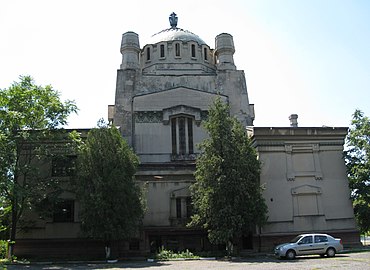

![Egyptian Theatre (DeKalb, Illinois), by Elmer F. Behrns, 1929–1930[28]](https://upload.wikimedia.org/wikipedia/commons/thumb/6/6d/Egyptian_Theatre_in_DeKalb_Il.jpg/202px-Egyptian_Theatre_in_DeKalb_Il.jpg)

![Carlton Cinema, Essex Road, Islington, London, by George Coles, 1930[29]](https://upload.wikimedia.org/wikipedia/commons/thumb/5/59/Carlton_Cinema%2C_Essex_Road_-_panoramio.jpg/290px-Carlton_Cinema%2C_Essex_Road_-_panoramio.jpg)
![Mixed with Postmodernism - Luxor Hotel and Casino in Las Vegas, by Veldon Simpson and Perini Building Company, 1992–1993[30]](https://upload.wikimedia.org/wikipedia/commons/thumb/2/2a/Las_Vegas_Luxor_04.jpg/360px-Las_Vegas_Luxor_04.jpg)

